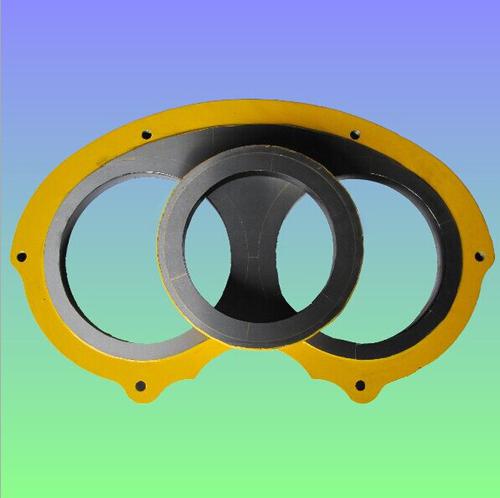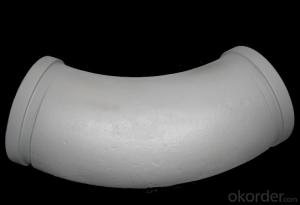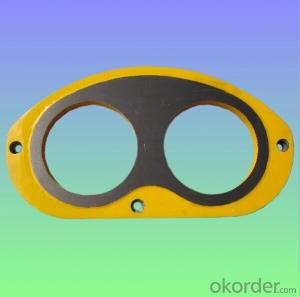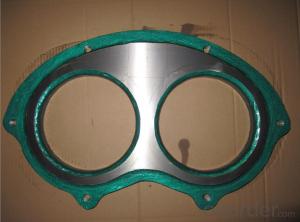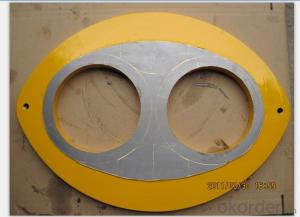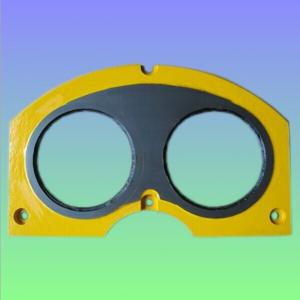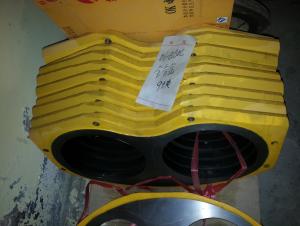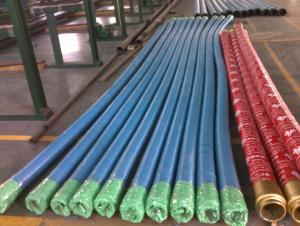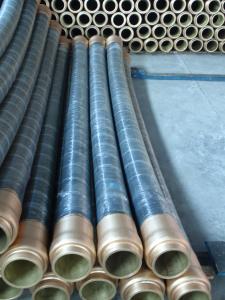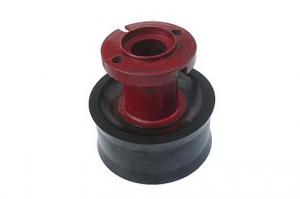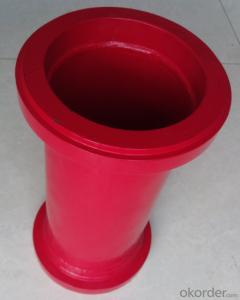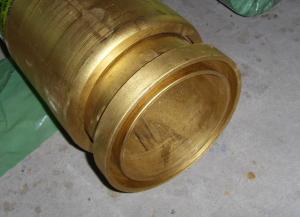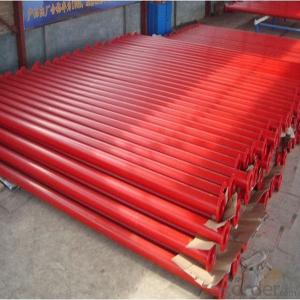SANY Spectacle Plate and Wear Ring DN230
- Loading Port:
- Tianjin
- Payment Terms:
- TT or LC
- Min Order Qty:
- 3 pc
- Supply Capability:
- 1000 pc/month
OKorder Service Pledge
OKorder Financial Service
You Might Also Like
Product Name: SANY Spectacle Plate and Wear Ring DN230
1. Specification
1. Material: Plate body S35C steel, tungsten carbide E5 grade ,
2. Lifetime: 30,000~80,000cbm
3. HRA≥86
4. Germany Welding rod used for hardfacing
5. tensile strength ≥ 2500 N/mm2
6. Application: trailer and trunk mounted Sany concrete pump
Notes: total series of Concrete Pump Spectacle Wear Plate and Cutting Ring for different brand concrete pump (PUTZMEISTER, SCHWING, CIFA, SANY, ZOOMLION, IHI, KYOKUTO,Niigata Etc) available from us.
2. Application
Our SANY Spectacle Plate and Wear Ring DN230 have been successfully exported to many countries from 1998, Our main markets as below: Middle East, Southeast Asia, America, Brazil, Italy, Russia, South Africa etc
Aiming at the largest concrete pump parts manufacturer, and reliable, professional supplier in China, we can supply concrete pump elbows, delivery pipes, casting or forging couplings, end rubber hoses, rubber pistons, tungsten wear plates, delivery cylinders, and other hydraulic parts, one stop service for your concrete pump parts and accessory business.
3. Package
Every 60pcs SANY Spectacle Plate and Wear Ring DN230 put in one seaworthy wooden box, and 20 boxes in one 20feet container.
FAQ:
Q1: Why buy Materials & Equipment from us?
A1: All products have its ISO certifications, adheres to the highest standards and a commitment to supply chain safety and customer satisfaction.
Q2: How do we guarantee the quality of our products?
A2: We have established an advanced quality management system which conducts strict quality tests at every step, from raw materials to the final product. At the same time, we provide extensive follow-up service assurances as required.
Q3: How soon can we receive the product after purchase?
A3: Within three days of placing an order, we will begin production. The specific shipping date is dependent upon international and government factors, but is typically 10 to 30 workdays.
Q4: If we can produce some SANY Spectacle Plate and Wear Ring DN230 according to customers request?
A4: Yes, we can produce SANY Spectacle Plate and Wear Ring DN230 according to the difference country situations and different concrete pump to make it suitable to the market and customers. We have very professional technical team to make the design.
Q5: How to make a quick resolution for after service?
A5:We have overseas branches all-around of world, IF needed, the seller shall dispatch 2 engineers to the buyer's site for supervision of training. The buyer shall make available of necessary facilities &skilled personnel at site for training.
Images:
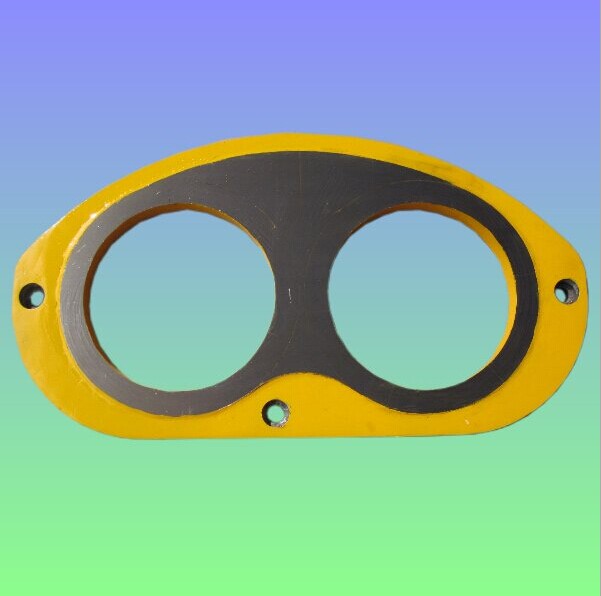
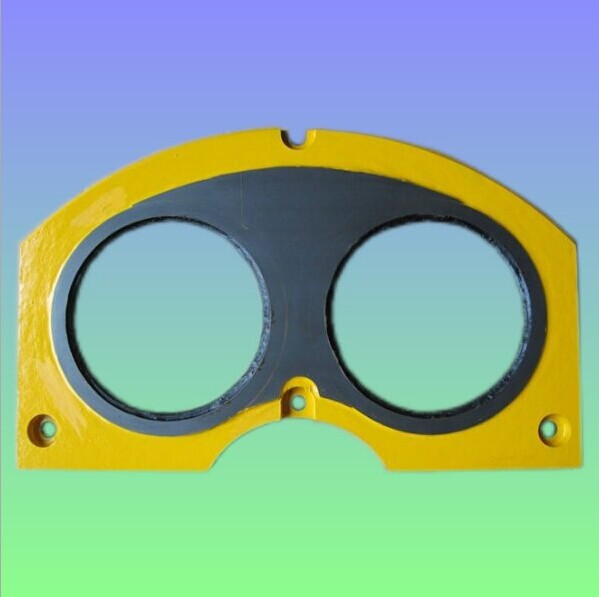
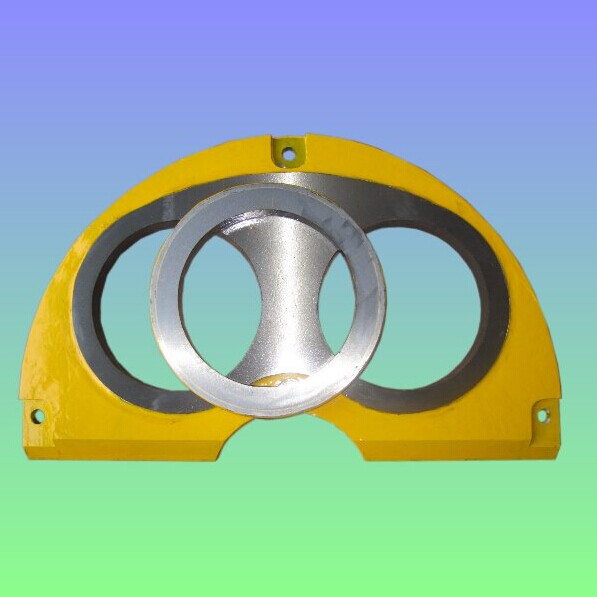
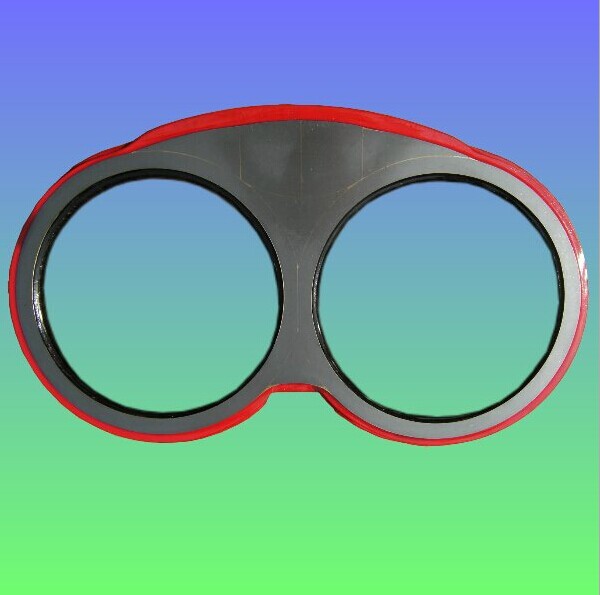
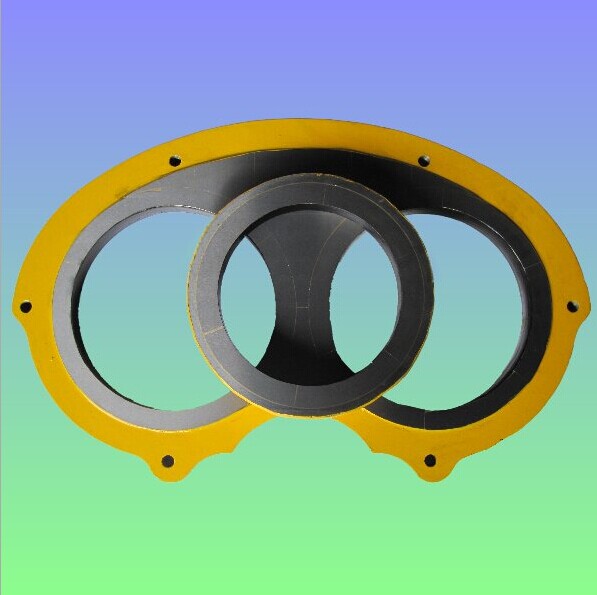
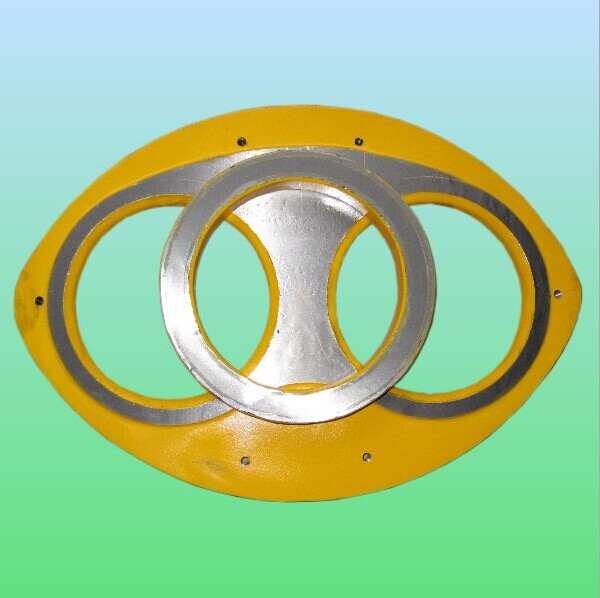
- Q: What are the signs of a malfunctioning hydraulic oil cooler?
- Some signs of a malfunctioning hydraulic oil cooler include overheating of the hydraulic system, decreased performance and efficiency of the equipment, increased hydraulic fluid leakage, abnormal noises or vibrations, and visible signs of coolant or oil leakage around the oil cooler.
- Q: How often should concrete pump control valves be inspected and replaced?
- Concrete pump control valves should be inspected regularly to ensure they are functioning properly and safely. The frequency of inspections will depend on the specific conditions and usage of the concrete pump. In general, it is recommended to inspect control valves at least once every three to six months. However, if the concrete pump is used extensively or in harsh conditions, more frequent inspections may be necessary. The decision to replace control valves should be based on the inspection results and the recommendations of the manufacturer or a qualified professional. If the control valves show signs of wear, damage, or malfunction, they should be replaced immediately to avoid any potential safety hazards or disruptions in the operation of the concrete pump. Regular maintenance and timely replacement of control valves are crucial to ensure the efficient and safe operation of the concrete pump.
- Q: Can I get spare parts for both concrete pumps with and without pressure washers?
- Yes, spare parts are available for both concrete pumps with and without pressure washers.
- Q: How often do I need to replace concrete pump spare parts?
- The frequency of replacing concrete pump spare parts largely depends on the usage and maintenance of the pump. However, it is generally recommended to inspect and replace worn-out or damaged parts regularly to ensure optimal performance and prevent any potential breakdowns.
- Q: What are the causes of pipe blockage in concrete pump?
- When the fine sand content through the 0.315mm screen is small, even if other concrete technical specifications meet the requirements, it will plug the pipe. Because these fine sand plays a similar role in the concrete, it can reduce the friction between the tube wall and concrete, improve the fluidity, increase the cohesion and water retention, and greatly affect the concrete pumping performance
- Q: What are the different types of concrete pump control system sensors?
- Concrete pump control systems utilize a variety of sensors to ensure smooth and efficient operation. These sensors are specifically designed to monitor different aspects of the pump's performance and provide real-time feedback to the control system. Common types of sensors used in concrete pump control systems include: 1. Pressure Sensors: These sensors measure the concrete pressure during pumping. They are typically installed in the discharge line and are crucial in preventing over-pressurization and potential damage to the pump or pipeline. 2. Flow Sensors: Flow sensors measure the rate at which concrete flows through the system. By monitoring the volume of concrete passing through per unit of time, these sensors enable the control system to regulate the pump's speed and output accordingly. 3. Level Sensors: Level sensors monitor the concrete level in the hopper or storage tank. They provide information about the concrete volume to prevent the pump from running dry or becoming overloaded, thus preventing pump cavitation or blockages. 4. Proximity Sensors: Proximity sensors detect the position of moving parts in the pump system, such as the boom or outriggers. They ensure safe operation by providing feedback to the control system and preventing collisions or obstructions. 5. Temperature Sensors: Temperature sensors monitor the concrete mix temperature. They help maintain the desired temperature range during pumping, which is crucial for workability and curing. Optimal concrete temperature contributes to the quality of the final product. In summary, these sensors work in harmony to provide precise feedback to the control system, ensuring efficient and safe operation of the concrete pump. By continuously monitoring and adjusting various parameters, these sensors optimize pumping performance and enhance productivity in concrete placement projects.
- Q: Is the main pump of the concrete pump electric control or hydraulic control?
- The main pump behind the oil pump to provide the size of the oil with the greater the current the higher the higher the higher the displacement,
- Q: What are the different types of concrete pump rubber pistons?
- There are several different types of concrete pump rubber pistons available in the market, each designed for specific applications and requirements. Some of the commonly used types include: 1. Single-Action Piston: This type of piston is designed to push the concrete forward during the pumping process. It moves in a single direction, providing a consistent and efficient flow of concrete. 2. Double-Action Piston: Unlike the single-action piston, the double-action piston can move in both directions. This allows for a more versatile pumping process and can be useful in situations where there are obstacles or restrictions in the pump line. 3. Steel Reinforced Piston: These pistons are reinforced with steel to provide additional strength and durability. They are commonly used in high-pressure pumping applications or when pumping abrasive materials. 4. Polyurethane Piston: Polyurethane pistons are known for their excellent wear resistance and longevity. They are often used in demanding pumping conditions where durability is crucial. 5. Rubber Sponge Piston: Rubber sponge pistons are designed to have a soft and flexible surface, allowing them to conform to irregularities in the pump line. They are particularly useful in situations where there may be bends or corners in the line. 6. Bonded Piston: Bonded pistons are made by bonding a rubber or polyurethane material to a metal core. This combination provides both the flexibility of rubber and the strength of metal, making them suitable for various pumping applications. It is important to choose the right type of concrete pump rubber piston based on the specific requirements of the project. Factors such as pumping pressure, material being pumped, and environmental conditions should be considered to ensure optimal performance and longevity of the piston.
- Q: How can a faulty oil cooler affect the pump's hydraulic system?
- The pump's hydraulic system can be affected in multiple ways by a defective oil cooler. Firstly, it is the responsibility of the oil cooler to maintain the hydraulic oil at an optimal temperature. If the oil cooler is flawed and fails to cool the oil efficiently, the hydraulic oil may become overheated. This can result in a decrease in the oil's viscosity, causing it to lose its lubricating properties. Consequently, the pump's moving parts may experience heightened friction and wear, leading to reduced efficiency and potential damage to the pump itself. Secondly, a defective oil cooler can lead to inadequate cooling of the hydraulic oil, resulting in elevated temperatures within the system. Elevated temperatures can cause the oil to oxidize, leading to the formation of sludge and varnish deposits. These deposits can obstruct the smooth operation of the hydraulic system, including the pump, valves, and other components, potentially causing malfunctions. Furthermore, a faulty oil cooler can also cause a decrease in the rate of oil flow. If the oil cooler is not functioning properly, it can restrict the flow of hydraulic oil, reducing the amount of oil available for the pump's operation. This can result in decreased hydraulic pressure, affecting the pump's performance and potentially causing issues such as reduced power output or inadequate operation of hydraulic actuators. In summary, a defective oil cooler can have negative effects on the pump's hydraulic system, including overheating, increased friction and wear, the formation of deposits, and a reduced oil flow rate. It is essential to regularly inspect and maintain the oil cooler to ensure proper functioning and prevent potential damage to the hydraulic system.
- Q: How can a malfunctioning control panel affect the pump's operation?
- A malfunctioning control panel can have various negative impacts on the operation of a pump. Firstly, the control panel is responsible for monitoring and controlling the pump's functions, such as starting, stopping, and regulating the flow of fluids. If the control panel malfunctions, it may fail to send accurate signals to the pump, leading to erratic or incorrect operation. Additionally, a malfunctioning control panel can result in a loss of communication between the pump and other components or systems. For instance, if the control panel fails to relay important information to the pump's sensors or other control devices, it may not be able to react appropriately to changes in pressure, temperature, or flow rate. This can lead to inefficient performance, potential damage to the pump, or even complete failure. Furthermore, a malfunctioning control panel may also impact the safety of the pump's operation. Control panels often incorporate safety features like emergency shutdowns or alarms to prevent hazardous situations. If these safety mechanisms are compromised due to a malfunction, it can increase the risk of accidents, equipment damage, or even harm to personnel. In summary, a malfunctioning control panel can disrupt the proper functioning of a pump by causing operational inconsistencies, loss of communication with other components, decreased efficiency, increased risk of accidents, and potential damage to the pump itself. Therefore, it is crucial to regularly inspect and maintain control panels to ensure their proper functioning and minimize the chances of any negative impact on the pump's operation.
Send your message to us
SANY Spectacle Plate and Wear Ring DN230
- Loading Port:
- Tianjin
- Payment Terms:
- TT or LC
- Min Order Qty:
- 3 pc
- Supply Capability:
- 1000 pc/month
OKorder Service Pledge
OKorder Financial Service
Similar products
Hot products
Hot Searches
Related keywords


